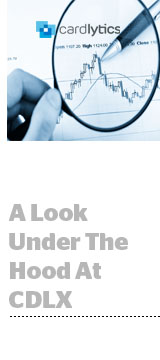
When Atlanta-based Cardlytics filed its initial S-1 on Jan. 12, it revealed important details about its business.
The company, which creates measurement and analytics products for marketers based on purchase data, amended its S-1 last Monday, when it priced 5.4 million shares at $13 to $15 per share.
Those terms value Cardlytics’ initial public offering at about $76 million.
In 2016, Cardlytics’ revenue was $113 million, while revenue in the first nine months of 2017 was $91 million.
While the company has raised more than $200 million since it was founded in 2008, it has experienced ongoing net losses. Cardlytics reportedly laid off 15% of its workforce – or about 50 people – in 2016 as part of a corporate restructuring.
Here are some of the salient points from Cardlytics’ S-1:
Bank of America is its cash cow
Cardlytics’ biggest client is Bank of America. It also works with other major financial institutions, including PNC Bank and Lloyds in the United Kingdom.
But Bank of America is one of Cardlytics longest partners and now represents more than 50% of Cardlytics’ monthly active users.
Cardlytics’ software sits behind a bank’s firewall and powers rewards and card-linked offers programs like Bank of America’s BankAmeriDeals. This setup keeps transactional information secure and ensures no personally identifiable information leaves the financial provider’s premises.
Because every banking partner captures and manages data differently, Cardlytics claims it can aggregate and standardize analytics across different data sets to create more uniformity.
It applies purchase intelligence to programmatic buying
In 2016, Cardlytics ramped up its ties to the digital advertising ecosystem.
While Cardlytics’ original solution is essentially a purchase intelligence platform that lets marketers reach consumers in their online and mobile banking channels, it also has a managed service that runs targeted marketing campaigns beyond banking channels through partnerships with ad tech vendors like demand-side platforms.
That strategy helped Cardlytics expand the use of purchase data outside of the banking channel to sweeten the value prop for marketers.
“We intend to continue to partner with other media platforms, marketing technology providers and marketing agencies that can utilize our platform to serve a broad array of customers,” the company wrote in its S-1.
Its reach is substantial
Cardlytics aggregates purchase data from about 2,000 financial institutions. In 2016, its platform analyzed more than 18 billion online and in-store transactions across more than 94 million bank accounts in the US.
Because of its scale and view across multiple data sets, the company claims it can identify with more certainty consumers who are likeliest to buy based on their purchase histories – and measure the actual sales impact of a media campaign.
This post was syndicated from Ad Exchanger.

More Stories
Inside AB InBev’s Strategy For Tapping Into First-Party Data
PMX New Zealand sponsors Ehrenberg-Bass
Chief Sustainability Officers Aren’t Marketers, They’re Multi-Hyphenates